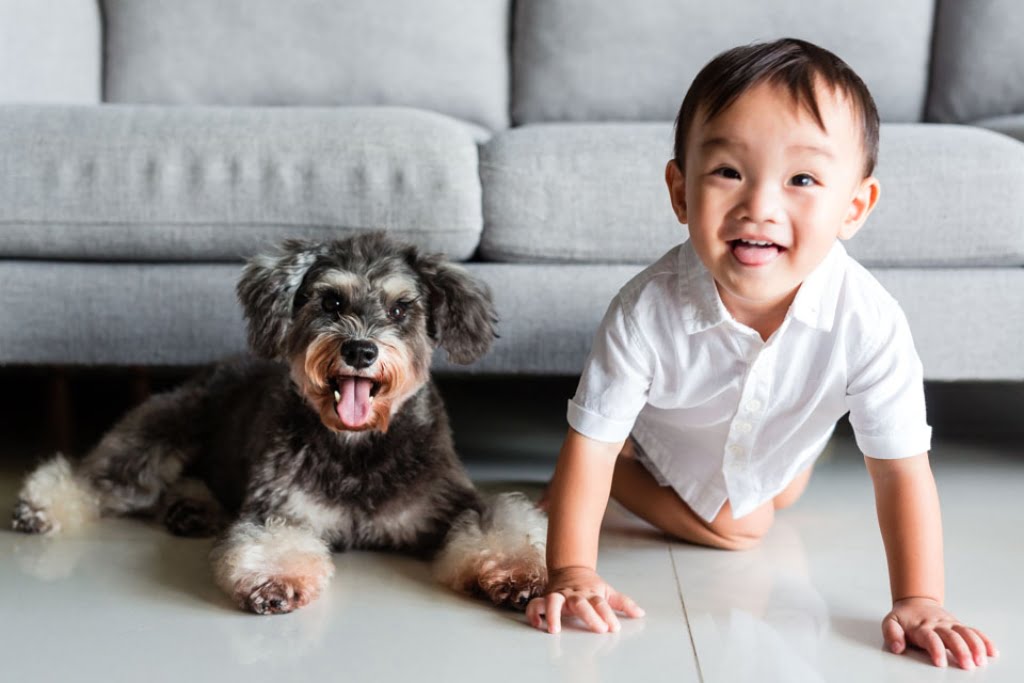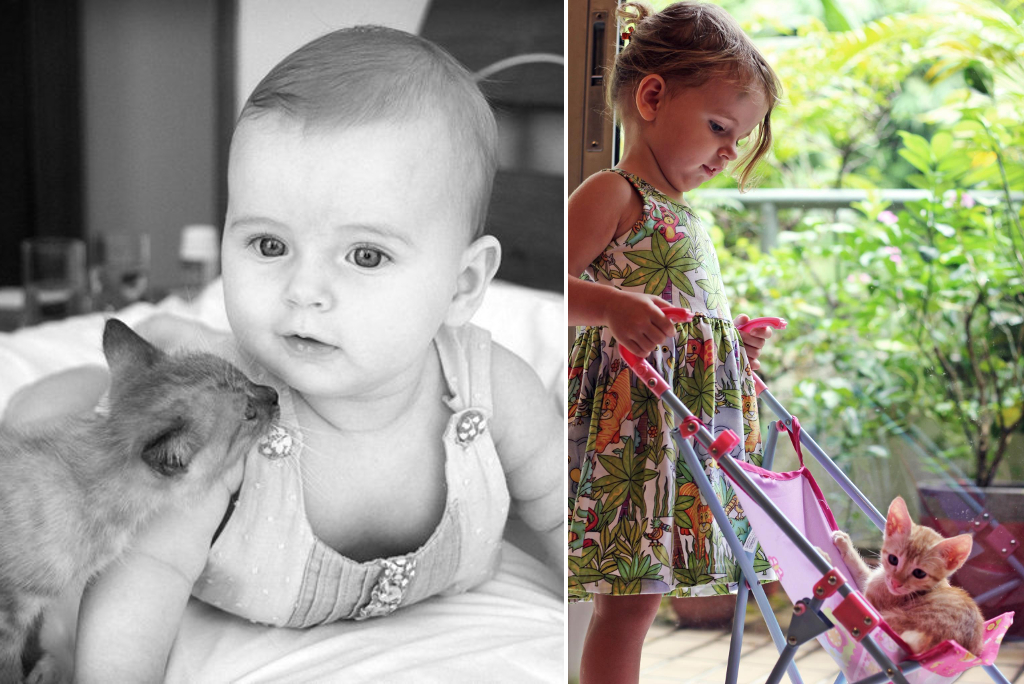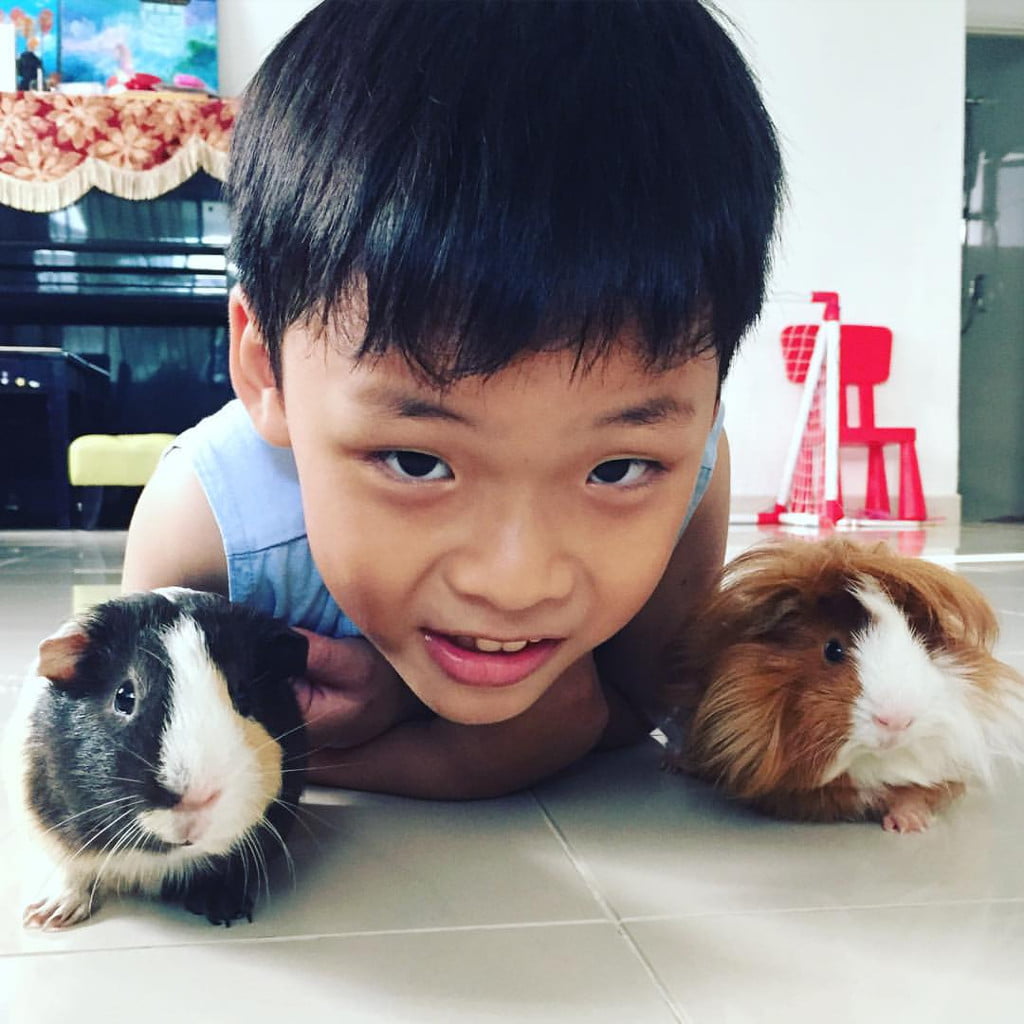SingaporeMotherhood | Family Fun
September 2016
Kids and Pets: What’s the Ideal Pet for Your Family + Must-See Adorable Photos of Children and Their Best Fur-Friends

It’s proven that growing up with pets has many benefits for children. If you don’t yet have pets but are considering one, we share the pros and cons to help you decide on the best fit for your family. Also check out the bond some young Singaporean kids share with their beloved animal buddies.
Pets can have a huge impact on the lives of families, starting with empowering children to learn a large variety of skills. Add to that health and fitness benefits, plus emotional support and behavioural improvements, and it’s clear that the presence of animal companions can have lasting advantages for our children.
(See also: How A Pet Can Help Your Child)
For example, Dr June McNicholas at the University of Warwick found that children in families with pets do better at school than children without pets. Tests of immune function further demonstrated that children with pets have more stable immune systems and are better able to fend off illnesses. Dr McNicholas also found that pet owners are less likely to suffer from depression and psychological issues. According to Merck Veterinary Manual, people with pets live longer. They need fewer doctor visits and are less likely to suffer from insomnia or heart conditions.
On top of the health perks, British wildlife TV presenter Michaela Strachan says that her family dogs have had a really positive impact on her kids. “Owning a pet can increase a child’s sense of responsibility, nurture a more caring attitude and develop self-confidence and, in the case of having a dog, it encourages kids to get outside more.”
So what pet should you adopt? Unlike in some countries where you might have exotic pets like hedgehogs and iguanas, our options in Singapore are more limited. Still, let’s take a look at which animal companions you might consider introducing to your household.
The One with the Waggledy Tail
 Image cc licensed (CC BY 2.0) flickr image Sooner or later she may attempt to ride on his back… by mliu92
Image cc licensed (CC BY 2.0) flickr image Sooner or later she may attempt to ride on his back… by mliu92
Pros: Dogs are instinctively empathetic. They make it their job to cheer you up when you’re down, plus they’re always happy to see you and never judge. Many children (and adults) look to their dogs when they’re upset or afraid. When 10-year-old Derrick Goh failed his Chinese exams, he confided first in his Golden Retriever. “I was afraid to tell my parents because I knew they would be disappointed. But Toby doesn’t care about that.” Many dogs are also great babysitters, and help to keep an eye on baby. If she wakes up and cries, Fido is likely to alert you to it. Children who grow up with dogs also tend to be more empathetic, outgoing and handle stress better.
Cons: The variety of dog breeds also means that not every dog will be suitable for your family. Some, like the Pug or Golden Retriever, are great with kids, but others like the Silky Terrier or Chihuahua, may have nippy personalities that are unsuitable for young children. While there are too many to list here, make sure that you do your research as to what breed will work with your family. Dogs also require daily walks, training, grooming and usually don’t like being left alone at home. For those who are concerned with shedding and dander allergies, you can consider breeds like the Schnauzer or Poodle, both of which have hypoallergenic coats.
Cats in the Cradle

Pros: Most cats are self-cleaning, easy to toilet train and are usually less needy than dogs, while still providing loving companionship. They do well in small apartments, don’t require walks, and seldom suffer separation anxiety if left alone at home for a bit. Most cat owners also agree that the vibration of a cat’s purr is therapeutic and calming. In fact, scientists have discovered that it is beneficial to the healing of wounds, fractures and damaged muscles. According to Leslie A. Lyons, associate professor at University of Missouri School of Veterinary Medicine and Surgery, sound frequencies created by the purring of cats are in a range (25-150 Hz) that can improve bone density and promote healing. A study at the University of Minnesota also found that cats may reduce your chances of a heart attack by 40 per cent.
Cons: Cats do tend to shed, so expect to have to vacuum regularly. They do have really stinky poo and pee, so you’ll have to keep their litter boxes pristine. Cats also like to scratch, so provide them with appropriate scratching posts and clip their claws to keep your furniture – and family members – scratch-free.
Ehh…What’s Up, Doc?

Pros: Rabbits are often misunderstood, with many thinking that they are just cute, fluffy things that are happy in a cage. Actually, bunnies have huge personalities and are amusing and entertaining to watch. A happy bunny doing a binky is guaranteed to bring a smile to your face even if you’re having a bad day. Like cats, rabbits are mostly self-cleaning, don’t need daily walks and are easily litter-trained. In fact, they are highly trainable, much like a dog in this regard. They are also crepuscular, meaning that they are most active at dawn and dusk, great for school-going kids who can interact with them before and after school. Oh, and while they do ‘bark’ occasionally to show displeasure, your neighbours aren’t likely to complain about the noise they make.
Cons: While some rabbits love to be held and snuggled, others might not appreciate it. Their spines are also fragile and can be hurt from being ‘squished’ too hard or dropped from heights, which is why they are better for families with slightly older (and gentler) kids. Long-haired rabbits will require more grooming. They have specific dietary requirements – no, veggie scraps aren’t enough – so like with any other pet, do make sure you do your research beforehand.
Of Mice and Men

Pros: Rodents that make good pets range from guinea pigs, gerbils and hamsters to mice and rats. They require less attention than dogs and cats, with most quite happy to keep themselves entertained, provided you create a suitable living habitat for them. If socialised from a young age, most are also happy to be cuddled gently by their human counterparts, with guinea pigs leading the affectionate list. Furthermore, a 2012 survey of 1,000 pet-owning children (aged 5-16 years) in the UK revealed that having rats and mice had the most positive effect on grades at school, followed by dogs and then cats. 79 per cent of the children believed that their pets helped them focus when it was time to do their homework.
Cons: Cleaning guinea pig, hamster and mouse cages needs to be done regularly as the smell factor can get out of hand quite quickly. Rats, despite their negative reputation, are actually intelligent, fastidious and will keep their cages virtually scent-free. Gerbils and guinea pigs are least likely – and hamsters the most likely – to bite inquisitive fingers. They may all be rodents, but they all vary in personalities and needs. For example, Syrian hamsters are solitary animals while mice and gerbils are highly social. You’ll have to decide which works best for your family, depending on personalities and how many pets (and cages and all they entail) you might want.
Birds of a Feather

Pros: Birds vary greatly from species to species, but some birds that make great pets include the canary and many small parrots like lovebirds, budgies, lorikeets and cockatiels. Some, like the larger African Grey, can have the intelligence of a five-year-old, making them great playmates as well. Many can understand humans and mimic our speech, which is great fun for toddlers who can learn words alongside their pet birds! Most birds are naturally sociable and love to play and keep you company, don’t have to be taken for walks, and love to hang out with the person they have bonded with the most.
Cons: Birds are sensitive to quick movements and sudden loud noises, so little grabbing hands can be perceived as a threat. A bird might respond by biting or trying to fly away, so supervision is required for younger children, and older children should be taught how to handle their bird correctly. While birds can live in cages, small cages are not recommended, even if they are let out regularly for exercise. Like toddlers, they do require a fair amount of attention and may develop behavioural problems if bored. These include flinging bits of food around, plucking their own feathers, self-mutilation and constant screeching.
The Cutest Best Friends
 Credit: Furry Photos
Credit: Furry Photos
Elliott’s mum, lecturer Selene Goh, 40, says that when asked if Moon, a nine-year-old Miniature Schnauzer, bullies Elliott, her answer is always: “Elliott bullies her! But despite his less-than-gentle ways of hugging and kissing her, even pulling her tail, Moon is super patient and just puts up with it. She is the sweetest fur sibling!” On the positive side for Moon, Elliott is always dropping food on the floor. “Moon will happily vacuum it up in seconds. So our floor is very clean!” Selene chuckles.
(See also: Confessions of a Germphobe Mom)
 Credit: Furry Photos
Credit: Furry Photos
It’s a work in progress, but now that Elliott is older (30 months), he is learning to be gentler. “He will always include Moon whenever we talk about family,” adds Selene. “When we’re going out, he’d say: ‘Daddy go, Mummy go, Moon go,’ and we’d have to explain that Moon can’t go to the malls with us. Every night at bedtime, Elliott will go: ‘Goodnight Daddy, goodnight Mummy, goodnight Moon,’ even though Moon has her own bed outside the room and can’t even hear him.”

Meet five-year-old Shayne and his playmate, Tippy. His mother, 33-year-old marketing manager, Cai Suqi, shares that because both Shayne and his baby sister have had bronchiolitis growing up, doctors have advised them to give up the cats. “People judge me for being a bad mum for putting the cats before my children’s health. I feel that children can outgrow allergies, but it will be hard to outgrow a phobia of animals, or even develop compassion for other living creatures. Besides, the cats make the children happy!”
(See also: Singapore’s Dust Mite Fight: Save Your Money, Sun Your Pillows)

This is Shayne’s 15-month-old baby sister, Sarah, with her best friends, Kitty and Tippy. Suqi says that they found Kitty as a kitten in a drain about two months before Shayne was born, and the two were BFFs. Then along came Sarah in 2015 and Kitty had a new pal. The cats don’t usually come when they’re called, but they always respond to Sarah. She will sit down and pat the floor, making a “tsk tsk tsk” sound, and the cats will trot over and allow her to pat, kiss and even attempt to carry them.”

A third-generation hawker, Li Ruifang, 32, says that she has kept lovebirds since 2008 and now has five. “When my baby girl, Kyra, was born in June this year, it never crossed my mind to give them up. They are my feather-kids too, and my husband and I hand-fed them with baby bird formula when they were hatchlings – not so different from human babies!”

“The birds were wary and timid when they first saw Kyra, but slowly warmed up. When Kyra first began to notice them, she would laugh and gurgle when they flew near. I read about babies who have dogs or cats at home being less prone to allergies. So hopefully, the birds will work the same magic with Kyra!”

“We adopted a pair of Labrador Retriever siblings Lilo and Otis when they were just seven months old,” says Petrina Lau, owner of local pet shop, Pets’ Love. “They were our babies, until the arrival of their younger human brother, Gareth. Sibling rivalry reared its head a little – it was a contest of who got mummy’s attention to clean up poop! It took a little reassurance from us, but the dogs soon became Gareth’s personal bodyguards.”

Gareth’s little brother came along two years ago, and Lilo took baby Gerald under her big furry paw, even ‘protecting’ him from eager relatives. “It is up to us as owners to help assimilate the dogs to new additions to the family. For example, when I gave birth, my husband brought home a blanket with the scent of our newborn so that the dogs would get used to it,” recalls Petrina. “Now their favourite activity is taking Gerald for walks!”

Fido and Darth Mao were kittens that marketing professional Elaine Quek, 38, and her husband rescued in turn 13 and two years ago. “We affectionately called them ‘our boys’ and we were a complete family of four,” Elaine relates. “Then baby Liam came along six months ago and became one of ‘our boys’. There was never a question of whether they were going to get along. It was just a matter of finding techniques to introduce them and make sure it worked out.”

They let the cats smell the baby’s swaddle before he came home from the hospital. “The cats took turns sniffing but they were as interested in baby scents as they were with cheese. Not very!” quipped Elaine. “Turns out, the cats were very chill towards the new addition. Whenever Liam cried, the cats would look askance at the noise and then go back to their naps. Now when he’s on his play mat, the cats would take pains to walk around the perimeter, as if respecting territory.” Elaine looks forward to when Liam grows older and becomes good friends with his two ‘brothers’.

Originally from Switzerland, avid animal lover Margaret Dunn and her husband moved to Singapore about 10 years ago. She volunteered in many roles with the SPCA here, including helping to foster puppies and kittens. “I continued fostering even after my daughter was born, so little Faye grew up among them and learned early on how to care for creatures littler than her. She also developed compassion and a sense of responsibility,” smiles her proud mother.

“Those character traits came in useful when her brother Gustav was born – she was a born babysitter and taught him how to be gentle with animals too,” Margaret continues. “Along the way, we also adopted two dogs through the SPCA, both of which became the children’s guardian angels.” The family has recently moved to South Africa, with the kids’ beloved Snowy and Mausebaer in tow.

Nine-year-old Elliott Yap is the proud owner of two guinea pigs. He and his two sisters had named them Peppa and George, and Elliott discovered a special affinity with them from day one. “He is really gentle with the piggies and spends a lot of time at ground level to keep them company!” says his mother, primary school teacher Patsy Teo, 42.

Elliott’s younger sister, six-year-old Amanda, loves to carry and kiss the guinea pigs. Sadly, she seems to have developed an allergy to them recently. “She gets a rash on her face because she loves to kiss them, but it’s not stopped her. It’s sad, but I just try to make sure she takes a shower right after playing with the piggies,” shares Patsy, who herself had grown up with pet hamsters, terrapins and an Australian Silky Terrier.

Public service officer Chong Poh Choo adopted Dachshund-crossbreed puppy Chaplin from the SPCA 10 years ago. “He is a happy dog but had resource guarding issues – he might snap and bite when you try to take his toys away. Now that he’s older, he’s mellowed and is always tolerant, even nurturing, towards Oliver.” Having been surrounded by animals since he was in the womb, 3.5-year-old Oliver has no fear of them, and Poh Choo says he has learnt to treat all animals with kindness and respect.

“Like most toddlers, Oliver used to be quite rough when he was younger. But we always supervise and these days, he can control his muscles better and he is the gentlest petter around!” He also gets on well with Zeus, a three-legged Chihuahua-cross. “When we sent the dogs to our relatives’ place recently as we were going on a short vacation, Oliver actually asked me, ‘Mama, where’s Cha Cha and Zeus?’ He missed them. It was the sweetest thing!”
Before you run out and purchase a new family pet, remember to factor in the life expectancy of your choice of pet, even while making sure everyone in the family is on board with the decision. Do also consider adopting from the SPCA or other animal shelter. You could give an animal that truly needs a home a new lease on life, even while adding a new member to your family.
In the meantime, for more adorable photos of kids and pets, just look to social media. For instance, check out the antics of Scottish Fold and Korean toddler @Airi_and_baby, or French Bulldog and his Japanese brothers @ayasakai. Closer to home, adopted local kitties Peanut and Butter (above) have just welcomed a new addition to their family @peanutbutterkitty.
Perhaps one of the most high-profile pet owners on social media is Facebook CEO Mark Zuckerberg. His Hungarian Puli has his own Facebook page boasting over two million fans. We’ll leave you with this photo of Beast spending his fifth birthday earlier this year dutifully watching over his newborn ‘sister’, Max.
All content from this article, including images, cannot be reproduced without credits or written permission from SingaporeMotherhood.
Follow us on Facebook, Instagram, and Telegram for the latest article and promotion updates.





